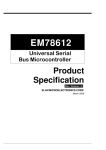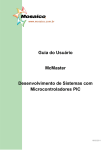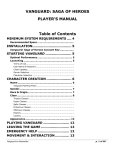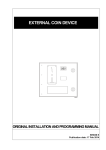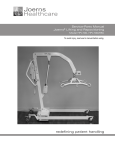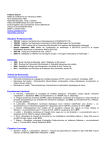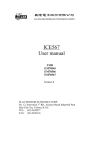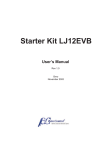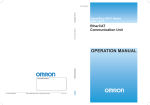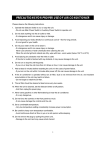Download EM78612
Transcript
EM78612 Universal Serial Bus Microcontroller Product Specification DOC. VERSION 1.4 ELAN MICROELECTRONICS CORP. November 2011 Trademark Acknowledgments: IBM is a registered trademark and PS/2 is a trademark of IBM. Windows is a trademark of Microsoft Corporation. ELAN and ELAN logo are trademarks of ELAN Microelectronics Corporation. Copyright © 2003~2011 by ELAN Microelectronics Corporation All Rights Reserved Printed in Taiwan The contents of in this specification are subject to change without notice. ELAN Microelectronics assumes no responsibility concerning the accuracy, adequacy, or completeness of this specification. ELAN Microelectronics makes no commitment to update, or to keep current the information and material contained in this specification. Such information and material may change to conform to each confirmed order. In no event shall ELAN Microelectronics be made responsible to any claims attributed to errors, omissions, or other inaccuracies in the information or material contained in this specification. ELAN Microelectronics shall not be liable for direct, indirect, special incidental, or consequential damages arising out of the use of such information or material. The software (if any) described in this specification is furnished under a license or nondisclosure agreement, and may be used or copied only in accordance with the terms of such agreement. ELAN Microelectronics products are not intended for use in life support appliances, devices, or systems. Use of ELAN Microelectronics product in such applications is not supported and is prohibited. NO PART OF THIS SPECIFICATION MAY BE REPRODUCED OR TRANSMITTED IN ANY FORM OR BY ANY MEANS WITHOUT THE EXPRESS WRITTEN PERMISSION OF ELAN MICROELECTRONICS. ELAN MICROELECTRONICS CORPORATION Headquarters: Hong Kong: USA: No. 12, Innovation 1st Road Hsinchu Science Park Hsinchu, TAIWAN 30076 Tel: +886 3 563-9977 Fax: +886 3 563-9966 [email protected] http://www.emc.com.tw Elan (HK) Microelectronics Corporation, Ltd. Flat A, 19F., World Tech Centre 95 How Ming Street, Kwun Tong Kowloon, HONG KONG Tel: +852 2723-3376 Fax: +852 2723-7780 Elan Information Technology Group (U.S.A.) PO Box 601 Cupertino, CA 95015 U.S.A. Tel: +1 408 366-8225 Fax: +1 408 366-8225 Korea: Shenzhen: Shanghai: Elan Korea Electronics Company, Ltd. Elan Microelectronics Shenzhen, Ltd. ELAN Microelectronics Shanghai, Ltd. 301 Dong-A Building 632 Kojan-Dong, Namdong-ku Incheon City, KOREA Tel: +82 32 814-7730 Fax: +82 32 813-7730 3F, SSMEC Bldg., Gaoxin S. Ave. I Shenzhen Hi-tech Industrial Park (South Area), Shenzhen CHINA 518057 Tel: +86 755 2601-0565 Fax: +86 755 2601-0500 [email protected] Rm101, #3 Lane 289, Bisheng Rd., Zhangjiang Hi-Tech Park Pudong New Area, Shanghai, CHINA 201204 Tel: +86 21 5080-3866 Fax: +86 21 5080-0273 [email protected] Contents Contents 1 2 3 4 5 6 General Description ...................................................................................................1 Features ......................................................................................................................1 Application..................................................................................................................2 Pin Description...........................................................................................................3 Block Diagram ............................................................................................................4 Function Description .................................................................................................4 6.1 Program Memory................................................................................................ 4 6.2 Data Memory ...................................................................................................... 5 6.2.1 6.2.2 6.3 I/O Ports ........................................................................................................... 17 6.3.1 6.3.2 6.4 Power-on Reset.................................................................................................19 Watchdog Reset................................................................................................19 USB Reset.........................................................................................................19 Power Saving Mode ......................................................................................... 19 6.6.1 6.6.2 7 8 9 Detect PS/2 or USB Mode ................................................................................17 USB Device Controller – UDC ..........................................................................18 Device Address and Endpoints .........................................................................18 Reset ................................................................................................................ 19 6.5.1 6.5.2 6.5.3 6.6 Programmable Large Current ...........................................................................17 Wake up by Port Change Function ...................................................................17 USB Application................................................................................................ 17 6.4.1 6.4.2 6.4.3 6.5 Special Purpose Registers ..................................................................................5 6.2.1.1 Operation Registers in Bank 0 .............................................................6 6.2.1.2 Control Registers in Bank 0 ...............................................................12 USB Application FIFOs .....................................................................................16 Power Down Mode ............................................................................................19 Dual Clock Mode ...............................................................................................20 6.7 Interrupt ............................................................................................................ 20 Absolute Maximum Ratings ....................................................................................21 DC Electrical Characteristic ....................................................................................22 Application Circuits .................................................................................................24 APPENDIX A B C Special Register Map ...............................................................................................25 Instruction Set ..........................................................................................................26 Code Option Register ..............................................................................................29 Product Specification (V1.4) 11.23.2011 • iii Contents Specification Revision History Doc. Version 1.0 Revision Description Date Initial Version 2003/03/05 1. Modified some text on the General Description. 1.1 2. Modified the Pin Description of EM78612. 3. Updated the Special Purpose Register. 2006/03/17 4. Modified the R4 Example of Selecting Bank. 1.2 1.3 1.4 iv • Modified the resonator Cap. of the application circuit 1. Modified the package type. 2. Added Appendix D. 1. Remove Pin Configuration. 2. Remove Package Outline Dimension 2007/03/30 2008/10/01 2011/11/23 Product Specification (V1.4) 11.23.2011 EM78612 Universal Serial Bus Microcontroller 1 General Description The EM78612 is a series of 8-bit Universal Serial Bus (USB), RISC architecture microcontroller. It is specifically designed for USB low speed device application and to support legacy device such as PS/2 mouse. The EM78612 also support one device address and two endpoints. The EM78612 has 5-level stacks and 6 interrupt sources. It has a maximum of 12 General Input/Output pins. Each device has 80 bytes SRAM. The ROM capacity of the EM78612 is 2K. These series of ICs have Dual Clock mode which allows the device to run on low power saving frequency. 2 Features Low-cost solution for low-speed USB devices, such as mouse, joystick, and gamepad. USB Specification Compliance • Universal Serial Bus Specification Version 1.1 • USB Device Class Definition for Human Interface Device (HID), Firmware Specification Version 1.1 • Supports 1 device address and 2 endpoints (EP0 and EP1) USB Application • USB protocol handling • USB device state handling • Identifies and decodes Standard USB commands to EndPoint Zero PS/2 Application Support • Built-in PS/2 port interface Built-in 8-bit RISC MCU • 5-level stacks for subroutine and interrupt • 6 available interrupts • 8-bit real time clock/counter (TCC) with overflow interrupt • Built-in RC oscillator free running for Watchdog Timer and Dual clock mode • Two independent programmable prescalers for WDT and TCC • Two power saving methods: 1. Power-down mode (Sleep mode) 2. Low frequency mode • Two clocks per instruction cycle I/O Ports Product Specification (V1.4) 11.23.2011 (This specification is subject to change without further notice) •1 EM78612 Universal Serial Bus Microcontroller • Up to 12 general purposes I/O pins grouped into two ports (Port 6 and 7). • Up to two LED sink pins • Each GPIO pin of Ports 6 and Port 7 has an internal programmable pull-high resistor. • Each GPIO pin of Port 6 has an internal programmable pull-low resistor. • Each GPIO pin wakes up the MCU from sleep mode by input state change. Internal Memory • Built-in 2048×13 bits Mask ROM • Built-in 80 bytes general purpose registers (SRAM) • Built-in USB Application FIFOs Operation Frequency • Normal Mode: MCU runs on the external oscillator frequency • Dual Clock Mode: MCU runs at the frequency of 256kHz (or 32kHz, 4kHz, 500Hz), emitted by the internal oscillator with the external ceramic resonator turned off to save power. Built-in 3.3V Voltage Regulator 3 • For MCU power supply • Pull-up source for the external USB resistor on D-pin. Application This microcontroller is designed for USB low speed device application or non-USB embedded devices. It is also suitable for PS/2 mouse application. 2• Product Specification (V1.4) 11.23.2011 (This specification is subject to change without further notice) EM78612 Universal Serial Bus Microcontroller 4 Pin Description Table 4-1 Pin Name II/O P60 ~ P67 I/O Function Port 6 has up to 8 GIOP pins. P70 ~ P73 I/O The pull-high resistors (132KΩ) and pull-low resistors (10KΩ) are selected through pin programming. Port 7 has up to 4 GIOP pins. The sink current of P70 and P71 are programmable for driving an LED. Each pin has pull-high resistors (132KΩ) that can be selected through pin programming. USB Plus data line interface or PS/2 line interface are user-defined through firmware setting. D+ / P50 I/O When the EM78612 is running under PS/2 mode, this pin will have an internal pull-high resistor (2.2KΩ), with VDD=5.0V. When this pin is used as a PS/2 line interface, it will generate an interrupt when its state changes (Port 5 state change interrupt enable). D- / P51 I/O USB Minus data line interface or PS/2 line interface are user-defined through firmware setting. When the EM78612 is running under PS/2 mode, this pin will have an internal pulled-high resistor (2.2KΩ), with VDD=5.0V. When this pin is used as a PS/2 line interface, it will generate an interrupt when its state changes (Port 5 state change interrupt enable). When the EM78612 is running under USB mode, this pin will have an internal pull-high resistor, 1.5KΩ, with V3.3=3.3V. OSCI I 6MHz/12 MHz ceramic resonator input. OSCO I/O Return path for 6MHz/12MHz ceramic resonator. V3.3V O 3.3V DC voltage output from internal regulator. This pin should be tied to a 4.7µF decoupling capacitor to GND. VDD - Connect to the USB power source or to a nominal 5V-power supply. Actual VDD range can vary between 4.4V and 5.2V. VSS - Connect to ground. Product Specification (V1.4) 11.23.2011 (This specification is subject to change without further notice) •3 EM78612 Universal Serial Bus Microcontroller 5 Block Diagram OSCI Built-in RC OSCO Reset & Sleep & Wake up Control WDT Timer V3.3 D+ 3.3V Regulator Oscillator Timing Control Prescaler WDT VDD Prescaler TCC R1 (TCC) D- R2 (PC) Transceiver ROM USB Device Controller Instruction register RAM Stack1 Stack2 Stack3 Stack4 Stack5 R3 (Status) ALU Interrupt Control Instruction Decoder R4 (RSR) ACC DATA & CONTROL BUS P50/D+/Clk P51/D-/Data I/O Port 5 I/O Port 6 P60 P61 P62 P63 P64 P65 P66 P67 I/O Port 7 P70 P71 P72 P73 Figure 5-1 EM78612 Series Functional Block Diagram 6 Function Description The memory of EM78612 is organized into four spaces, namely; User Program Memory in 2048×13 bits Mask ROM space, Data Memory in 80 bytes SRAM space, and USB Application FIFOs (for EndPoint 0 and EndPoint 1). Furthermore, several registers are used for special purposes. 6.1 Program Memory The program space of the EM78612 is 2K words, and is divided into two pages. Each page has 1K words long. After Reset, the 12-bit Program Counter (PC) points to location zero of the program space. It has two interrupt vectors, i.e., Interrupt Vectors at 0x0001 and USB Application Interrupt Vectors at 0x000A. The Interrupt Vector applies to TCC Interrupt, and Port 5 State Changed Interrupt. The USB Application Interrupt Vector is for USB EndPoint Zero Interrupt, USB Suspend Interrupt, USB Reset interrupt, and USB Host Resume Interrupt. 4• Product Specification (V1.4) 11.23.2011 (This specification is subject to change without further notice) EM78612 Universal Serial Bus Microcontroller After an interrupt, the MCU will fetch the next instruction from the corresponding address as illustrated in the following diagram. After reset Program Counter Address Reset Vector 0×0000 0×0001 Interrupt Vector 0×000A USB Application Interrupt Vector Page 0 0×03FF 0×0400 Page 1 0×07FF Figure 6-1 Program ROM Organization of EM78612 When executing “RETI” instruction, the MCU will pop A, R3, R4 and stack, and enable an interrupt. 6.2 Data Memory The Data Memory has 80 bytes SRAM space. It is also equipped with USB Application FIFO space for USB Application. Figure 6-2 shows the organization of the Data Memory Space. 6.2.1 Special Purpose Registers When the microcontroller executes the instruction, specific registers are invoked for assistance, such as Status Register which records the calculation status, Port I/O Control Registers which control the I/O pins’ direction, etc. The EM78612 series provides a lot more of other special purpose registers with different functions. There are 15 Special Operation Registers which are located from Address 0×00 to 0x0F, and 10 more Special Control Registers are available to control various functions or I/O direction. These are arranged from Address 0×05 to 0×0F. Note Special Control Registers can only be read or written to by two instructions, namely; IOR and IOW. Product Specification (V1.4) 11.23.2011 (This specification is subject to change without further notice) •5 EM78612 Universal Serial Bus Microcontroller 00 01 02 03 04 R0 R1 R2 R3 R4 (Indirection Addressing Register) (Time Clock / Counter Register) (Program Counter) & Stack (Status Register) (RAM Select Register) 05 06 07 08 09 R5 R6 R7 R8 R9 (Data line I/O Register) (Port 6 I/O Register) (Port 7 I/O Register) (Port6 wakeup pin selection Register) (Port7 wakeup pin selection Register) 0C 0D 0E 0F 10 IOC5 IOC6 IOC7 IOC8 IOCA (Operation mode Control Register) IOCB (Port 6 pull low Control Register) IOCC (Port 6 pull high Control Register) IOCD (Port 7 pull high Control Register) IOCE (Special Function Control Register) IOCF (Interrupt Mask Register) RC (USB Application Status Register) RD (USB Application FIFO address register) RE (USB Application FIFO data register) RF (Interrupt Status Register) 00 01 10 11 General Purpose Register 1F (Port 5 I/O Control Register) (Port 6 I/O Control Register) (Port 7 I/O Control Register) (Sink Curent Control Register) EP0's FIFO EP1's FIFO Data Byte Pointer of EP0 Data Byte Pointer of EP1 20 General Purpose Registers (Bank0) Byte0 Byte1 Byte2 Byte3 Byte4 Byte5 Byte6 Byte7 General Purpose Registers (Bank1) 3F Figure 6-2 Data RAM Organization 6.2.1.1 Operation Registers in Bank 0 The following introduces each of the Operation Registers under the Special Purpose Registers. The Operation Registers are arranged according to the order of the registers’ address. Note that some registers are read only, while others are both readable and writable. R0 (Indirect Address Register) Default Value: (0B_0000_0000) R0 is not a physically implemented register. Its major function is to act as an indirect address pointer. Any instruction using R0 as a pointer actually accesses the data pointed by the RAM Select Register (R4). R1 (Time / Clock Counter) Default Value: (0B_0000_0000) The TCC register is an 8-bit timer or counter. It is readable and writable as any other registers. The Timer module will increment every instruction cycle. User can work around this by writing an adjusted value. The Timer interrupt is generated when the R1 register overflows from FFh to 00h. This overflow sets bit TCIF (RF[0]). The interrupt can be masked by clearing bit TCIE (IOCF[0]). After Power-on reset and Watchdog reset, the initial value of this register is 0x00. R2 (Program Counter and Stack) Default Value: (0B_0000_0000) The EM78612 Program Counter is an 11-bit long register that allows access to 2K bytes of Program Memory with 5-level stacks. The eight LSB bits, 00~07, are located 6• Product Specification (V1.4) 11.23.2011 (This specification is subject to change without further notice) EM78612 Universal Serial Bus Microcontroller at R2, while the one MSB Bit 10, is located at R3 [5].The Program Counter is cleared after Power-on reset or Watchdog reset. The first instruction that is executed after a reset is located at Address 00h. R3 07 06 05 04 03 02 01 00 CALL 10 09 08 07 06 05 04 03 02 01 00 R2 PAGE0 0 PAGE1 1 Stack1 RET RETL RETI 0000 ~ 03FF Stack2 Stack3 E Stack4 Stack5 0400 ~ 07FF Figure 6-3 The Structure of ROM Page R3 (Status Register) Default Value:(0B_0001_1000) Bit 7 Bit 6 Bit 5 Bit 4 Bit 3 Bit 2 Bit 1 Bit 0 - - PS0 T P Z DC C R3 [0] Carry / Borrow flag. For ADD, SUB Instructions 0: No carry-out from the Most Significant bit of the result occurred 1: A carry-out from the Most Significant bit of the result occurred NOTE For Borrow, the polarity is reversed. For rotate (RRC, RLC) instructions, this bit is loaded with either the high or low-order bit of the source register. R3 [1] Auxiliary carry / borrow flag. For ADD, SUB Instructions 0: No carry-out from the 4th low-order bit of the result 1: A carry-out from the 4th low-order bit of the result occurred NOTE For Borrow, the polarity is reversed. R3 [2] Zero flag. It will be set to 1 when the result of an arithmetic or logic operation is zero. R3 [3] Power down flag. It will be set to 1 during Power-on phase or by “WDTC” command and cleared when the MCU enters into Power down mode. It remains in previous state after Watchdog Reset. 0: Power down 1: Power-on Product Specification (V1.4) 11.23.2011 (This specification is subject to change without further notice) •7 EM78612 Universal Serial Bus Microcontroller R3 [4] Time-out flag. It will be set to 1 during Power-on phase or by “WDTC” command. It is reset to 0 by WDT time-out. 0: Watchdog timer with overflow 1: Watchdog timer without overflow The various states of Power down flag and Time-out flag at different conditions are shown below: T P 1 1 0 1 1 1 1 *P 0 0 Condition Power-on reset WDTC instruction WDT time-out Power down mode Wakeup caused by port change during Power down mode * P: Previous status before WDT reset R3 [5] Page select bit. This bit is used to select a page of program memory (refer to R2, Program Counter). PS0 Program Memory Page [Address] 0 Page 0 [0000-03FF] 1 Page 1 [0400-07FF] R3 [6, 7]: Reserved registers R4 (RAM Select Register) Default Value: (0B_0xxx_xxxx) Bit 7 Bit 6 Bit 5 Bit 4 Bit 3 Bit 2 Bit 1 Bit 0 - BK0 Ad5 Ad4 Ad3 Ad2 Ad1 Ad0 R4 (RAM select register) contains the address of the registers. R4 [0~5] are used to select registers in 0x00h~0x3Fh. The Address 0x00~0x1F is common space. After 0x1Fh, SRAM is grouped into two banks. R4 [6] are used to select register banks. To select a registers bank, refer to the following examples and the table below: R4=01111100 points to the Register 0x3C in Bank 1. R4[6]Bk0 RAM Bank # 0 1 Bank 0 Bank 1 R5 (Data Line I/O Register) Default Value: (0B_0000_0000) Bit 7 Bit 6 Bit 5 Bit 4 Bit 3 Bit 2 - - - - - - Bit 1 Bit 0 D- or DATA D+ or CLK R5 [0] USB D+ line register or PS/2 clock interface register R5 [1] USB D- line register or PS/2 data interface register 8• Product Specification (V1.4) 11.23.2011 (This specification is subject to change without further notice) EM78612 Universal Serial Bus Microcontroller These two bits are both writable and readable when the MCU is operating in PS/2 mode. But in USB Mode, these two bits cannot be accessed. R5 [2~7] Not Used. The value is zero. R6 (Port 6 I/O Register) Default Value: (0B_0000_0000) Bit 7 Bit 6 Bit 5 Bit 4 Bit 3 Bit 2 Bit 1 Bit 0 P67 P66 P65 P64 P63 P62 P61 P60 R7 (Port 7 I/O Register) Default Value: (0B_0000_0000) Bit 7 Bit 6 Bit 5 Bit 4 Bit 3 Bit 2 Bit 1 Bit 0 - - - - P73 P72 P71 P70 R8 (Port 6 Wake-up Pin Selection Register) Default Value: (0B_1111_1111) Bit 7 Bit 6 Bit 5 Bit 4 Bit 3 Bit 2 Bit 1 Bit 0 /Wu67 /wu66 /Wu65 /Wu64 /Wu63 /Wu62 /Wu61 /Wu60 R8 [0 ~ 7] Select which of the Port 6 pins are to be defined to wake up the MCU from sleep mode. When the state of the selected pins changes during sleep mode, the MCU will wake up and automatically execute the next instruction. 0: Enable the wake-up function 1: Disable the wake-up function R9 (Port 7 Wake-up Pin Selection Register) Default Value: (0B_1111_1111) Bit 7 Bit 6 Bit 5 Bit 4 Bit 3 Bit 2 Bit 1 Bit 0 - - - - /Wu73 /Wu72 /Wu71 /Wu70 R9 [0 ~ 3] Select which of the Port 7 pins are to be defined to wake-up the MCU from sleep mode. When the state of the selected pins changes during sleep mode, the MCU will wake up and automatically execute the next instruction. 0: Enable the wake-up function 1: Disable the wake-up function RC (USB Application Status Register) Default Value: (0B_0000_0000) Bit 7 Bit 6 Bit 5 Bit 4 Bit 3 Bit 2 Bit 1 Bit 0 EP0_W EP0_R EP1_R 0 Device_Resume Host_Suspend EP0_Busy Stall RC [0] Stall flag. When the MCU receives an unsupported command or invalid parameters from host, this bit will be set to 1 by the firmware to notify the UDC to return a STALL handshake. When a successful SETUP transaction is received, this bit is automatically cleared. This bit is both readable and writable. RC [1] EP0 Busy flag. When this bit is equal to “1,” it indicates that the UDC is writing data into the EP0’s FIFO or reading data from it. During this time, the firmware will avoid accessing the FIFO until the UDC finishes writing or reading. This bit is only readable. Product Specification (V1.4) 11.23.2011 (This specification is subject to change without further notice) •9 EM78612 Universal Serial Bus Microcontroller RC [2] Host Suspend flag. If this bit is equal to 1, it indicates that the USB bus has no traffic for a specified period of 3.0 ms. This bit will also be cleared automatically when a bus activity takes place. This bit is only readable. * This bit should be used in Dual Mode RC [3] Device Resume flag. This bit is set by firmware to generate a signal to wake up the USB host and is cleared as soon as the USB Suspend signal becomes low. This bit can only be set by firmware and cleared by hardware. * This bit should be used in Dual Mode RC [4] Undefined Register. The default value is 0. RC [5, 6] EP1_R / EP0_R flag. These two bits inform the UDC to read the data written by firmware from the FIFO. Then the UDC automatically sends the data to the host. After the UDC finishes reading the data from the FIFO, this bit is cleared automatically. Therefore, before writing data into the FIFO, the firmware will first check this bit to prevent overwriting the existing data. These two bits can only be set by the firmware and cleared by the hardware. RC [7] EP0_W flag. After the UDC completes writing data to the FIFO, this bit will be set automatically. The firmware will clear it as soon as it gets the data from EP0’s FIFO. Only when this bit is cleared will the UDC will be able to write a new data into the FIFO. Therefore, before the firmware can write data into the FIFO, this bit must first be set by the firmware to prevent the UDC from writing data at the same time. This bit is both readable and writable. RD (USB Application FIFO Address Register) Default Value: (0B_0000_0000) Bit 7 Bit 6 Bit 5 Bit 4 Bit 3 Bit 2 Bit 1 Bit 0 0 0 0 UAD4 UAD3 UAD2 UAD1 UAD0 RD [0~4] USB Application FIFO address registers. These five bits are the address pointer of USB Application FIFO. RD [5~7] Undefined registers. The default value is zero. RE (USB Application FIFO Data Register) Default Value: (0B_0000_0000) Bit 7 Bit 6 Bit 5 Bit 4 Bit 3 Bit 2 Bit 1 Bit 0 UD7 UD6 UD5 UD4 UD3 UD2 UD1 UD0 RE (USB Application FIFO data register) contains the data in the register of which address is pointed by RD. 10 • Product Specification (V1.4) 11.23.2011 (This specification is subject to change without further notice) EM78612 Universal Serial Bus Microcontroller NOTE For example, if we want to read the fourth byte of the EndPoint Zero, we will use the address of EP0 (0x00) and Data Byte Pointer of EP0 (0x10) to access it. // Read the 4th byte of the EP0 FIFO // First, assign the data byte pointer of EP0 Register (0X10) with 0X03. MOV A, @0X10 MOVRD, a // Move data in A to RD register MOV A, @0X03 MOVRE , A // Move data in A to RE register // Then read the contents from EP0 FIFO (0x00) 4th byte MOV A, @0X00 MOVRD, A // Assign address point to EP0 FIFO MOVA, RE // Read the fourth byte data (Byte 3) of the EP0 FIFO MOV A, 0X0E // Read the fifth byte data (Byte 4) of the EP0 FIFO RF (Interrupt Status Register) Default Value: (0B_0000_0000) Bit 7 Bit 6 - -- Bit 5 Bit 4 Bit 3 Bit 2 Port 5 State USB Host USB USB Change_IF Resume_IF Reset_IF Suspend_IF Bit 1 Bit 0 EP0_IF TCC_IF RF [0] TCC Overflow interrupt flag. It will be set while TCC overflows, and is cleared by the firmware. RF [1] EndPoint Zero interrupt flag. It will be set when the EM78612 receives Vendor/Customer Command to EndPoint Zero. This bit is cleared by the firmware. RF [2] USB Suspend interrupt flag. It will be set when the EM78612 finds the USB Suspend Signal on the USB bus. This bit is cleared by firmware. RF [3] USB Reset interrupt flag. It will be set when the host issues the USB Reset signal. RF [4] USB Host Resume interrupt flag. It is set only in Dual Clock mode when the USB suspend signal becomes low. RF [5] Port 5 State Change interrupt flag. It is set when the Port 5 state changes. (Port 5 state change interrupt only works in PS/2 mode.) RF [6] Default value is zero and user should not modify it. R10~R1F are General purpose registers. These registers can be used no matter what Bank Selector is. There are 2 banks (BK0 and BK1) R20~R3F General purpose registers, selected by R4 [6]. Product Specification (V1.4) 11.23.2011 (This specification is subject to change without further notice) • 11 EM78612 Universal Serial Bus Microcontroller 6.2.1.2 Control Registers in Bank 0 Special purpose registers for special control purposes are also available. Except for the Accumulator (A), these registers must be read and written to by special instructions. One of these registers, CONT, can only be read by the instruction "CONTR" and written to by the "CONTW" instruction. The remaining special control registers can be read by the instruction "IOR" and written to by the instruction "IOW." A (Accumulator Register) Internal data transfer operation, or instruction operand holding usually involves the temporary storage function of the Accumulator. The Accumulator is an 8-bit un addressable register. CONT (Control Register) Bit 7 Bit 6 Bit 5 Bit 4 Bit 3 Bit 2 Bit 1 Bit 0 RW_E /INT TSR2 TSR1 TSR0 PSR2 PSR1 PSR0 NOTE The CONT register can be read by the instruction "CONTR" and written to by the instruction “CONTW." CONT [0~2] Watchdog Timer prescaler bits. These three bits are used as the prescaler of Watchdog Timer. CONT [3~5] TCC Timer prescaler bits. The relationship between the prescaler value and these bits are shown below: TCC Rate WDT Rate ( 8mS ) PSR2/TSR2 PSR1/TSR1 PSR0/TSR0 0 0 0 6 MHz / 2 8 ms 0 0 1 6 MHz / 4 16 ms 0 1 0 6 MHz / 8 32 ms 0 1 1 6 MHz / 16 64 ms 1 0 0 6 MHz / 32 128 ms 1 0 1 6 MHz / 64 256 ms 1 1 0 6 MHz / 128 512 ms 1 1 1 6 MHz / 256 1024 ms CONT [6] Interrupt enable control bit. This bit toggles the Interrupt function between enable and disable. It is set to 1 by the interrupt disable instruction "DISI" and reset by the interrupt enable instructions "ENI" or "RETI." 0: Enable the Interrupt function 1: Disable the Interrupt function 12 • Product Specification (V1.4) 11.23.2011 (This specification is subject to change without further notice) EM78612 Universal Serial Bus Microcontroller CONT [7] Remote wake-up enable bit. This bit is set to 1, if host enables the device to remote wake-up PC. It could be modified by SetFeature() and ClearFeature() Request. IOC5 ~IOC7 I/O Port Direction Control Registers Each bit controls the I/O direction of the three I/O ports (Port 5~Port 7) respectively. When these bits are set to 1, the relative I/O pins become input pins. Similarly, the I/O pins becomes outputs when the relative control bits are cleared. 0: Output direction 1: Input direction IOC5 (Data Line I/O Control Register) Default Value: (0B_0000_0011) Bit 7 Bit 6 Bit 5 Bit 4 Bit 3 Bit 2 Bit 1 Bit 0 0 0 0 0 0 0 P51 P50 IOC5 [2~7] Undefined registers. The default value is 0. IOC6 (Port 6 I/O Control Register) Default Value: (0B_1111_1111) Bit 7 Bit 6 Bit 5 Bit 4 Bit 3 Bit 2 Bit 1 Bit 0 P67 P66 P65 P64 P63 P62 P61 P60 IOC7 (Port 7 I/O Control Register) Default Value: (0B_0000_1111) Bit 7 Bit 6 Bit 5 Bit 4 Bit 3 Bit 2 Bit 1 Bit 0 - - - - P73 P72 P71 P70 IOC8 (Sink Current Control Register) Default Value: (0B_0000_0000) Bit 7 Bit 6 Bit 5 Bit 4 Bit 3 Bit 2 Bit 1 Bit 0 0 0 Sink1.1 Sink1.0 0 0 Sink01 Sink0.0 IOC8 [0, 1][4,5] are P70/P71 sink current control registers. Four levels are offered for selection: Sink 0.1/1.1 Sink 0.0/1.0 Sink Current 0 0 3 mA ± 10% 0 1 6 mA ± 10% 1 0 12 mA ± 10% 1 1 25 mA ± 10% The default current after Power-on reset is 3 mA. IOCA (Operation Mode Control Register) Default Value: (0B_1100_0011) Bit 7 Bit 6 Bit 5 Bit 4 Bit 3 Bit 2 Bit 1 Bit 0 Dual_Frq.1 Dual_Frq.0 0 0 0 0 PS/2 USB Product Specification (V1.4) 11.23.2011 (This specification is subject to change without further notice) • 13 EM78612 Universal Serial Bus Microcontroller IOCA [0, 1] These two bits are used to select the operation mode. The definition of these two control registers is described in the table below. IOCA[1] IOCA[0] 0 0 Operation Mode Detect Mode 0 1 USB Mode 1 0 PS/2 Mode 1 1 USB Test Mode IOCA [2~5] Undefined registers. The default value is 0. IOCA [6, 7] Select the operation frequency in Dual Clock Mode. Four frequencies are available and can be chosen as Dual Clock mode for running the MCU program. Dual_Frq.1 Dual_Frq.0 Frequency 0 0 500Hz 0 1 4kHz 1 0 32kHz 1 1 256kHz IOCB (Port 6 Pull-Low Control Register) Default Value: (0B_0000_0000) Bit 7 Bit 6 Bit 5 Bit 4 Bit 3 Bit 2 Bit 1 Bit 0 PL67 PL66 PL65 PL64 PL63 PL62 PL61 PL60 IOCB [0~7] Select whether the 10 KΩ pull-low resistor of Port 6 individual pin is connected or not. 0: Disable the pull-low function 1: Enable the pull-low function IOCC (Port 6 Pull-High Control Register) Default Value: (0B_0000_0000) Bit 7 Bit 6 Bit 5 Bit 4 Bit 3 Bit 2 Bit 1 Bit 0 PH67 PH66 PH65 PH64 PH63 PH62 PH61 PH60 IOCC [0~7] Select whether the 132 KΩ pull-high resistor of Port 6 individual pin is connected or not. 0: Disable the pull-high function 1: Enable the pull-high function IOCD (Port 7 Pull-High Control Register) Default Value: (0B_0000_0000) Bit 7 Bit 6 Bit 5 Bit 4 Bit 3 Bit 2 Bit 1 Bit 0 - - - - PH73 PH72 PH71 PH70 IOCD [0~3] Select whether the 132 KΩ pull-high resistor of Port 7 individual pin is connected or not. 0: Disable the pull-high function 14 • Product Specification (V1.4) 11.23.2011 (This specification is subject to change without further notice) EM78612 Universal Serial Bus Microcontroller 1: Enable the pull-high function IOCE (Special Function Control Register) Default Value: (0B_1111_0000) Bit 7 Bit 6 Bit 5 Bit 4 Bit 3 Bit 2 Bit 1 Bit 0 /Dual clock /WUE WTE RUN 0 0 0 0 IOCE [0~3] Undefined register. The default value is zero. IOCE [4] Run bit. This bit can be cleared by the firmware and set during power-on, or by the hardware at the falling edge of wake-up signal. When this bit is cleared, the clock system is disabled and the MCU enters into power down mode. At the transition of wake-up signal from high to low, this bit is set to enable the clock system. 0: Sleep mode. The EM78612 is in power down mode. 1: Run mode. The EM78612 is working normally. IOCE [5] Watchdog Timer enable bit. The bit disable/enables the Watchdog Timer. 0: Disable WDT 1: Enable WDT NOTE If the Code Option WTC bit is "0,” WDT is always disabled. IOCE [6] Enable the wake-up function as triggered by port-change. This bit is set by UDC. 0: Enable the wake-up function 1: Disable the wake-up function IOCE [7] Dual clock Control bit. This bit is used to select the frequency of the system clock. When this bit is cleared, the MCU will run on very low frequency saving power and the UDC will stop working. 0: Select to run on slow frequency. 1: Select EM78612 to run on normal frequency. IOCF (Interrupt Mask Register) Default Value: (0B_0000_0000) Bit 7 Bit 6 - - Bit 5 Bit 4 Port 5 State USB Host Change_IE Resume_1E Bit 3 USB Reset_IE Bit 2 Bit 1 Bit 0 USB EP0_IE TCC_IE Suspend_IE IOCF [0~5] TCC / EP0 / USB Suspend / USB Reset / USB Host Resume / Port 5 State Change enable bits. These eight bits respectively control the function of TCC interrupt, EP0 interrupt, USB Suspend interrupt, USB Reset interrupt, USB Host Resume interrupt, Port 5 State Change interrupt, Individual interrupt is enabled by setting its associated control bit in the IOCF to "1". 0: Disable Interrupt Product Specification (V1.4) 11.23.2011 (This specification is subject to change without further notice) • 15 EM78612 Universal Serial Bus Microcontroller 1: Enable Interrupt IOCF[6] The Default value is zero and user should not modify it. Only when the global interrupt is enabled by the ENI instruction will the individual interrupt works. After DISI instruction, any interrupt will not work even if the respective control bits of IOCF are set to 1. The USB Host Resume Interrupt works only in Dual clock mode. This is because when the MCU is in sleep mode, it will be automatically waken up by the UDC Resume signal. 6.2.2 USB Application FIFOs For USB Application, the EM78612 provides an 8-byte First-In-First-Out (FIFO) buffer for each endpoint. The buffer cannot be accessed directly. However, a corresponding Data Byte Pointer register for each endpoint is made available to address the individual byte of the FIFO buffer. The contents of the individual byte will map to a special register. Address (RD) 0X10 Data Byte Pointer of EP0 0X11 Data Byte Pointer of EP1 Counter 16 • 0X00 EP0's FIFO 0X01 EP1's FIFO Pointer Counter Pointer 0 0 1 1 2 2 3 3 4 4 5 5 6 6 7 7 Bi-directional Uni-directional Product Specification (V1.4) 11.23.2011 (This specification is subject to change without further notice) EM78612 Universal Serial Bus Microcontroller 6.3 I/O Ports The EM78612 has up to 12 General Purpose I/O pins, which are classified into two port groups; Port 6 and Port 7. Each pin has an internal resistor that can be individually selected by user. The following describes the important features of the EM78612 I/O pins. 6.3.1 Programmable Large Current Port 7 has two pins; P70 and P71 that can drive large currents of up to 30mA. The range of driving current is from 3mA to 30mA, which is programmable. Use IOC8 [0,1] and IOC8 [4,5] to control the sink current of P70/P71. The default current is 3mA. 6.3.2 Wake up by Port Change Function Each of the GPIO pins in Port 6 and Port 7 can wake-up the MCU through signal change from input pin. This function is used to wake-up the MCU automatically from sleep mode. It also supports the remote wake-up function for USB application. Any of the Individual pins of Port 6 and Port 7 can be defined to wake-up the MCU by setting their respective bits, R8 and R9. 6.4 USB Application The EM78612 is specially designed for USB device application and has many powerful functions that help the firmware to free itself from complex situation in various aspects of USB application. 6.4.1 Detect PS/2 or USB Mode When the EM78612 is connected to the bus, the firmware should detect and identify which type of bus (USB or PS/2) it is connected to. The conditions that influence the detect function are described below: 1. After a Power-on reset, the initial value of IOCA [0,1] is 0b00. Thus the operation mode is “Detect mode” and the D+ and D- I/O pins are internally pulled high by 200 KΩ to VDD. 2. The firmware checks the state of R5 [0,1]. If the state with which these two bits is 0b00, set the IOCA [0] to “1” to define the “USB mode.” Otherwise, set the IOCA [1] to “1,” to define “PS/2 mode.” 3. When the operation mode is defined as “USB mode,” the D- I/O pin is internally pulled high by a 1.5 KΩ resistor to 3.3V, which is output from a built-in regulator. 4. If the operation is in “PS/2 mode,” both of the PS/2 interface I/O pins are internally pulled high by a 2.2 KΩ resistor to VDD. Product Specification (V1.4) 11.23.2011 (This specification is subject to change without further notice) • 17 EM78612 Universal Serial Bus Microcontroller NOTE The firmware should set the operation mode, either in USB mode or PS/2 mode, at the beginning of the program. An additional mode, “USB Test Mode” is also available. This mode has no load on D+ and D- I/O pins, and can only be used in USB Applications. Therefore, an external 1.5KΩ resistor is needed to pull up the D- I/O pin to 3.3V. In “PS/2 mode,” both PS/2 pins are programmed to generate an interrupt. After setting the Port 5 State change to Interrupt Enable bit, the MCU will interrupt while the state of these two pins changes. 6.4.2 USB Device Controller – UDC The EM78612 has a built-in USB Device Controller (UDC) which can interpret the USB Standard Command and response automatically without involving the firmware. The embedded Series Interface Engine (SIE) handles the serialization and de-serialization of actual USB transmission. Hence, an IC developer can concentrate his efforts more in perfecting the device actual functions and spend less energy in dealing with USB transaction. The UDC handles and decodes most Standard USB commands defined in the USB Specification Rev1.1. If the UDC receives an unsupported command, it will set a flag to notify the MCU of the receipt of such command. The Standard Commands that the EM78612 supports includes; Clear Feature, Get Configuration, Get Interface, Get Status, Set Address, Set Configuration, Set Feature, and Set Interface. Each time the UDC receives a USB command, it writes the command into EP0’s FIFO. Only when it receives unsupported command will the UDC notify the MCU through interrupt. Therefore, the EM78612 is very flexible under USB application because the developer can freely choose the method of decoding the USB command as dictated by different situation. 6.4.3 Device Address and Endpoints The EM78612 supports one device address, two endpoints, EP0 for control endpoint, and EP1 for interrupt endpoint. Sending data to USB host in the EM78612 is very easy. Just write data into the EP’s FIFO, set the flag, and the UDC will handle the rest. It will then confirm that the USB host has received the correct data from the EM78612. 18 • Product Specification (V1.4) 11.23.2011 (This specification is subject to change without further notice) EM78612 Universal Serial Bus Microcontroller 6.5 Reset The EM78612 provides three types of reset: (1) Power-on Reset, (2) Watchdog Reset, and (3) USB Reset. 6.5.1 Power-on Reset Power-on Reset occurs when the device is attached to power and a reset signal is initiated. The signal will last until the MCU becomes stable. After a Power-on Reset, the MCU enters into the following predetermined states (see below), and then, it is ready to execute the program. A. The program counter is cleared. B. The TCC timer and Watchdog timer are cleared. C. Special registers and Special Control registers are all set to initial value. The MCU also has a low voltage detector that detects low output power condition. Whenever the output voltage of the 3.3V regulator decreases to below 2.2V, a reset signal is set off. 6.5.2 Watchdog Reset When the Watchdog timer overflows, it causes the Watchdog to reset. After it resets, the program is executed from the beginning and some registers will be reset. The UDC however, remains unaffected. 6.5.3 USB Reset When the UDC detects a USB Reset signal on the USB Bus, it interrupts the MCU, then proceed to perform the specified process that follows. After a USB device is attached to the USB port, it cannot respond to any bus transactions until it receives a USB Reset signal from the bus. 6.6 Power Saving Mode The EM78612 provides two options of power saving modes for energy conservation, i.e., Power Down mode, and Dual Clock mode. 6.6.1 Power Down Mode The EM78612 enters into Power Down mode by clearing the RUN register (IOCE[4]). During this mode, the oscillator is turned off and the MCU goes to sleep. It will wake up when signal from the USB host is resumed, or when the Watchdog resets, or the input port state changes. If the MCU wakes up when the I/O port status changes, the of I/O port direction should be set at input direction, then read the state of port. For example: Product Specification (V1.4) 11.23.2011 (This specification is subject to change without further notice) • 19 EM78612 Universal Serial Bus Microcontroller // Set Port 6 to input port MOV A,@0XFF IOW PORT 6 // Read the state of Port 6 MOV PORT 6,PORT 6 // Clear the RUN bit IOR 0X0E AND A,@0B11101111 IOW 0X0E : : 6.6.2 Dual Clock Mode The EM78612 has one internal oscillator for power saving application. Clearing Bit IOCE [7] will enable the low frequency oscillator. At the same time, the external oscillator will be turned off. Then the MCU will run under very low frequency to conserve power. Four types of frequency are available for selection in setting Bits IOCA [6, 7]. The USB Host Resume Interrupt can only be used in this mode. If this interrupt is enabled, the MCU will be interrupted when the USB Host Resume signal is detected on USB Bus. 6.7 Interrupt The EM78612 has two interrupt vectors, one is in 0x0001, and the other is in 0x000A. When an interrupt occurs while the MCU is running, it will jump to the interrupt vector (0x0001 or 0x000A) and execute the instructions sequentially from the interrupt vector. RF is the interrupt status register that records the interrupt status in the relative flags/bits. The interrupt condition could be one of the following: 20 • 1. TCC Overflow When the Timer Clock / Counter Register (R1) overflows, the status flag RF[0] will be set to 1. Its interrupt Vector is 0X0001. 2. EP0 Interrupt When the UDC successfully received a setup transaction from host to EndPoint0, the status flag RF[1] will be set to 1. Its interrupt Vector is 0X000A. 3. USB Suspend When UDC detects a USB Suspend signal on USB bus, the status flag RF[2] will be set to 1. Its interrupt Vector is 0X000A. 4. USB Reset When the UDC detects a USB Reset signal on the USB bus, the status flag RF[3] will be set to 1. Its interrupt Vector is 0X000A. Product Specification (V1.4) 11.23.2011 (This specification is subject to change without further notice) EM78612 Universal Serial Bus Microcontroller 5. USB Host Resume When UDC detects that the USB bus has left the Suspend condition, the status flag RF[4] will be set to 1. Its interrupt Vector is 0X000A. 6. Port 5 State Change When the input signals in Port 5 change, the status flag RF[5] will be set to 1. Its interrupt Vector is 0X0001. IOCF is an interrupt mask register which can be set individually bit by bit. While their respective bit is written as 0, the hardware interrupt will be inhibited, that is, the EM78612 will not jump to the interrupt vector to execute instructions. But the interrupt status flags still record the conditions no matter whether the interrupt is masked or not. The interrupt status flags must be cleared by firmware before leaving the interrupt service routine and enabling interrupts. The global interrupt is enabled by the ENI (RETI) instruction and is disabled by the DISI instruction. Interrupt flag. If a bit of RF is asserted, it means relative interrupt is requested. Priority of USB, TCC interrupt: USB > TCC. Additional hardware process/steps for an interrupt to occur, includes: A. Disabling an interrupt means reserving the next interrupt process until the instruction “RETI” is executed. B. Jump to interrupt vector C. Push “Accumulator”, “R3” and “R4”. Steps “A”, “B”, and “C” are executed at the same time. D. Clear “R3”and“R4” E. If the instruction “RETI” is executed, pop “Accumulator”, “R3” and “R4”. F. Return to main program and enable interrupt. Steps “E” and “F” are executed at the same time. 7 Absolute Maximum Ratings Symbol Min Max Unit 0 70 ºC Storage temperature -65 150 ºC Input voltage -0.5 6.0 V Output voltage -0.5 6.0 V Temperature under bias Product Specification (V1.4) 11.23.2011 (This specification is subject to change without further notice) • 21 EM78612 Universal Serial Bus Microcontroller 8 DC Electrical Characteristic T = 25°C, VDD = 5V, VSS = 0V Symbol Parameter Condition Min Type Max Unit 3.3V Regulator VRag Output voltage of 3.3V Regulator VDD = 5V Ireg 3.3V Regulator driving capacity 3.0 3.3 3.6 V V3.3 = 3.3V − − 100 mA − − ±1 µA MCU Operation IIL Input Leakage Current for input pins VIN= VDD,VSS VIHX Clock Input High Voltage OSCI 2.5 − - V VILX Clock Input Low Voltage OSCI − − 1.0 V ICC1 VDD operating supply current – Normal frequency operation mode − − 10 mA ISB Operating supply Current 1 – WDT disabled Power down mode − − 100 µA V Freq. = 6 MHz GPIO Pins 22 • VIH Input High Voltage Port 5 2.0 − − VIL Input Low Voltage Port 5 − − 0.8 V VIH Input High Voltage Port 6 & 7 2.0 − − V VIL Input Low Voltage Port 6 & 7 − − 0.8 V IOH1 Output High Voltage (Port 6 and P72~P73) VOH1 = 2.4V VREG = 3.3V − 11 − mA IOL1 Output Low Voltage (Port 6 ) VOL2 = 0.4V VREG = 3.3V − 11 − mA IOH2 Output High Voltage (Port 5) VOH2 = 2.4V VDD = 5V − 7 − mA IOL2 Output Low Voltage (Port 5) VOL2 = 2.4V VDD = 5V − 13 − mA − 100 − KΩ − 8 − KΩ RPH Pull-high resistor RPL Pull-low resistor Input pin with internal pull-high resistor of Port 6 or Port 7 is connected to VSS. input pin with internal pull-low resistor of Port 6 is connected to VDD. Product Specification (V1.4) 11.23.2011 (This specification is subject to change without further notice) EM78612 Universal Serial Bus Microcontroller Symbol Parameter Condition Min Type Max Unit USB Interface VOH Static Output High 2.8 − 3.6 V VOL Static Output Low - − 0.3 V 0.2 − − V 0.8 − 2.5 V 0.8 − 2.0 V − − 20 pF 3.0 − 3.6 V − 1.5 − KΩ -30% 3 +30% mA -30% 6 +30% mA -30% 12 +30% mA -30% 25 +30% mA VDI VCM VSE Differential Input Sensitivity USB operation Mode Differential Input Command Mode Range Single Ended Receiver Threshold CIN Transceiver Capacitance VRG Output Voltage of Internal Regulator RPH Pull-high resistor (D-) USB operation Mode Programmable Large Current ISink1 ISink2 ISink3 ISink4 P70, P71 Output Sink Current P70, P71 Output Sink Current P70, P71 Output Sink Current P70, P71 Output Sink Current Product Specification (V1.4) 11.23.2011 (This specification is subject to change without further notice) VOUT = 0.4V, IOC8[0,1] or IOC8[4,5] = 00 VOUT = 0.4V, IOC8[0,1] or IOC8[4,5] = 01 VOUT = 0.4V, IOC8[0,1] or IOC8[4,5] = 10 VOUT = 0.4V, IOC8[0,1] or IOC8[4,5] = 11 • 23 EM78612 Universal Serial Bus Microcontroller 9 Application Circuits USB Application V3.3 VDD EM78612 1 2 3 4 5 6 7 V3.3 8 9 C3 4.7uF 10 P60 P64 P61 P65 P62 P66 P63 P67 P70 P71 P72 P73 NC P50/D+/CLK VSS P51/D-/DATA V3.3 VDD OSCI OSCO R1 1.5k 20 19 P51 P50 18 17 USB connector 16 Note1. IF IOCA = USB mode, MCU D- pin internal pull-high to V3.3 with 1.5k resistor. 15 14 P50 13 P51 Note2. IF IOCA = USB test mode, it is necessary that D- pin external pull-high to V3.3 with 1.5k resistor. VDD 12 11 C1 10uF C2 0.1uF PS/2 Application Y1 C4 J1 1 2 3 4 C5 6MHz or 12MHz resonator 8pF J2 8pF VDD P50 Note : A. Place C1 and C2 close to MCU VDD pin. B. Place Y1, C4 and C5 close to MCU OSCI pin. C. In USB application, it is necessary to place C3 close to MCU V3.3 pin. D. Port6 and Port7 are 3.3V level I/O. P51 5 3 1 6 4 2 PS/2 connector Note3. IF IOCA = PS/2 mode, MCU CLK and DATA pin internal pull-high to VDD with 2.2k resistor. 24 • Product Specification (V1.4) 11.23.2011 (This specification is subject to change without further notice) EM78612 Universal Serial Bus Microcontroller APPENDIX A Special Register Map Addr Name Operation Registers Bit 7 Bit 6 Bit 5 Bit 4 Bit 3 Bit 2 Bit 1 Bit 0 Default Value 0x00 R0 Indirect Addressing Register 0B_0000_0000 0x01 R1 (TCC) Timer/Clock Counter 0B_0000_0000 0x02 R2 (PC) Program Counter 0B_0000_0000 0x03 R3 (Status) - - 0x04 R4 (RSR) - BK0 0x05 R5 (Port 5) - - - - - - 0x06 R6 (Port 6) P67 P66 P65 P64 P63 0x07 R7 (Port 7) - - - - /Wu67 /Wu66 /Wu65 - - EP0_R PS0 T P Z DC C Select the register(address: 00~3F) in the indirect addressing mode 0B_0001_1xxx 0B_0xxx_xxxx P51/D- P50/D+ /DATA /CLK P62 P61 P60 0B_0000_0000 P73 P72 P71 P70 0B_0000_0000 /Wu64 /Wu63 /Wu62 /Wu61 /Wu60 0B_1111_1111 - - /Wu73 /Wu72 /Wu71 /Wu70 0B_1111_1111 EP1_R 0 STALL 0B_0000_0000 0B_0000_0000 R8 (Port 6 0x08 Wake-up Pin Selection) R9 (Port 7 0x09 Wake-up Pin Selection) Device Host_ UDC_ Resume SUSPEND Writing 0x0C RC EP0_W 0x0D RD USB Application FIFO Address Register 0B_0000_0000 0x0E RE USB Application FIFO Data Register 0B_0000_0000 0x0F RF - EP1_IF Port 5 state USB Host USB USB change_IF Resume_ IF Reset_IF Suspend_IF Product Specification (V1.4) 11.23.2011 (This specification is subject to change without further notice) EP0_IF TCC_IF 0B_0000_0000 • 25 EM78612 Universal Serial Bus Microcontroller Addr Control Registers Name Bit 7 Bit 6 Bit 5 Bit 4 Bit 3 Bit 2 Bit 1 Bit 0 Default Value CONT RW_E INT TSR2 TSR1 TSR0 PSR2 PSR1 PSR0 0B_0100_0000 0x05 IOC5 Port 5 Direction Control Register 0B_0000_0011 0x06 IOC6 Port 6 Direction Control Register 0B_1111_1111 0x07 IOC7 Port 7 Direction Control Register 0B_0000_1111 IOC8 0x08 (Sink Current) 0x09 IOC9 0x0A IOCA 0x0B - - Sink[71]_1 Sink[71]_0 Sink[70]_1 Sink[70]_0 0B_0000_0000 - - - - PS/2 USB 0B_1100_0000 Reserved Dual_Frq Dual_Frq .1 .0 IOCB /PL67 /PL66 /PL65 /PL64 /PL63 /PL62 /PL61 /PL60 0B_0000_0000 0x0C IOCC /PH67 /PH66 /PH65 /PH64 /PH63 /PH62 /PH61 /PH60 0B_0000_0000 0x0D IOCD - - - - /PH73 /PH72 /PH71 /PH70 0B_0000_0000 0x0E IOCE /WUE WTE RUN 0 0 0 0 0B_1111_0000 0x0F IOCF USB USB EP0_IE TCC_IE 0B_0000_0000 /Dual clock 0 EP1_IE Port5_State USB HOST _Change_IE Resume_IF Reset_IE Suspend_IE B Instruction Set Each instruction in the instruction set is a 11-bit word divided into an OP code and one or more operands. All instructions are executed within one single instruction cycle (consisting of 2 oscillator periods), unless the program counter is changed by(a) Executing the instruction "MOV R2,A", "ADD R2,A", "TBL", or any other instructions that write to R2 (e.g. "SUB R2,A", "BS R2,6", "CLR R2", ⋅⋅⋅⋅). (b) execute CALL, RET, RETI, RETL, JMP, Conditional skip (JBS, JBC, JZ, JZA, DJZ, DJZA) which were tested to be true. Under these cases, the execution takes two instruction cycles. In addition, the instruction set has the following features: (1). Every bit of any register can be set, cleared, or tested directly. (2). The I/O register can be regarded as general register. That is, the same instruction can operate on I/O register. 26 • Product Specification (V1.4) 11.23.2011 (This specification is subject to change without further notice) EM78612 Universal Serial Bus Microcontroller Convention: R = Register designator that specifies which one of the registers (including operation and general purpose registers) is to be utilized by the instruction. Bits 6 and 7 determine the selected register bank. b = Bit field designator that selects the value for the bit located in the register R and which affects the operation. k = 8 or 10-bit constant or literal value Instruction Binary Hex Mnemonic Operation Status Affected 0 0000 0000 0000 0000 NOP No Operation 0 0000 0000 0001 0001 DAA Decimal Adjust A 0 0000 0000 0010 0002 CONTW A → CONT None 0 0000 0000 0011 0003 SLEP 0 → WDT, Stop oscillator T, P 0 0000 0000 0100 0004 WDTC 0 → WDT T, P 0 0000 0000 rrrr 000r IOW R A → IOCR None 1 0 0000 0001 0000 0010 ENI Enable Interrupt None None C 0 0000 0001 0001 0011 DISI Disable Interrupt None 0 0000 0001 0010 0012 RET [Top of Stack] → PC None 0 0000 0001 0011 0013 RETI [Top of Stack] → PC, Enable Interrupt A, R3, R4 0 0000 0001 0100 0014 CONTR CONT → A None 0 0000 0001 rrrr 001r IOR R IOCR → A None 1 0 0000 0010 0000 0020 TBL R2+A → R2, Bits 8~9 of R2 unchanged 0 0000 01rr rrrr 00rr MOV R,A A→R None 0 0000 1000 0000 0080 CLRA 0→A Z 0 0000 11rr rrrr 00rr CLR R 0→R 0 0001 00rr rrrr 01rr SUB A,R R-A → A Z, C, DC 0 0001 01rr rrrr 01rr SUB R,A R-A → R Z, C, DC 0 0001 10rr rrrr 01rr DECA R R-1 → A Z 0 0001 11rr rrrr 01rr DEC R R-1 → R Z 0 0010 00rr rrrr 02rr OR A,R A ∨ VR → A Z 0 0010 01rr rrrr 02rr OR R,A A ∨ VR → R Z 0 0010 10rr rrrr 02rr AND A,R A&R→A Z 0 0010 11rr rrrr 02rr AND R,A A&R→R Z 0 0011 00rr rrrr 03rr XOR A,R A⊕R→A Z 0 0011 01rr rrrr 03rr XOR R,A A⊕R→R Z 0 0011 10rr rrrr 03rr ADD A,R A+R→A Z, C, DC 0 0011 11rr rrrr 03rr ADD R,A A+R→R Z, C, DC 0 0100 00rr rrrr 04rr MOV A,R R→A Z 0 0100 01rr rrrr 04rr MOV R,R R→R Z Product Specification (V1.4) 11.23.2011 (This specification is subject to change without further notice) Z, C, DC Z • 27 EM78612 Universal Serial Bus Microcontroller Instruction Binary Hex Mnemonic Operation Status Affected 0 0100 10rr rrrr 04rr COMA R /R → A Z 0 0100 11rr rrrr 04rr COM R /R → R Z 0 0101 00rr rrrr 05rr INCA R R+1 → A Z 0 0101 01rr rrrr 05rr INC R R+1 → R Z 0 0101 10rr rrrr 05rr DJZA R R-1 → A, skip if zero None 0 0101 11rr rrrr 05rr DJZ R R-1 → R, skip if zero None 0 0110 00rr rrrr 06rr RRCA R R(n) → A(n-1), R(0) → C, C → A(7) C 0 0110 01rr rrrr 06rr RRC R R(n) → R(n-1), R(0) → C, C → R(7) C 0 0110 10rr rrrr 06rr RLCA R R(n) → A(n+1), R(7) → C, C → A(0) C 0 0110 11rr rrrr 06rr RLC R R(n) → R(n+1), R(7) → C, C → R(0) C 0 0111 00rr rrrr 07rr SWAPA R R(0-3) → A(4-7), R(4-7) → A(0-3) None 0 0111 01rr rrrr 07rr SWAP R R(0-3) ↔ R(4-7) None 0 0111 10rr rrrr 07rr JZA R R+1 → A, skip if zero None 0 0111 11rr rrrr 07rr JZ R R+1 → R, skip if zero None 0 100b bbrr rrrr 0xxx BC R,b 0 → R(b) None 2 0 101b bbrr rrrr 0xxx BS R,b 1 → R(b) None 0 110b bbrr rrrr 0xxx JBC R,b if R(b)=0, skip None 0 111b bbrr rrrr 0xxx JBS R,b if R(b)=1, skip None 1 00kk kkkk kkkk 1kkk CALL k PC+1 → [SP], (Page, k) → PC None 1 01kk kkkk kkkk 1kkk JMP k (Page, k) → PC None 1 1000 kkkk kkkk 18kk MOV A,k k→A None 1 1001 kkkk kkkk 19kk OR A,k A∨k→A Z 1 1010 kkkk kkkk 1Akk AND A,k A&k→A Z 1 1011 kkkk kkkk 1Bkk XOR A,k A⊕k→A Z 1 1100 kkkk kkkk 1Ckk RETL k k → A, [Top of Stack] → PC 1 1101 kkkk kkkk 1Dkk SUB A,k k-A → A Z, C, DC 1 1111 kkkk kkkk 1Fkk ADD A,k k+A → A Z, C, DC None 1 Note: This instruction is applicable for IOCx only 2 This instruction is not recommended for RE and RF operation 28 • Product Specification (V1.4) 11.23.2011 (This specification is subject to change without further notice) EM78612 Universal Serial Bus Microcontroller C Code Option Register The EM78612 has one Code option register, which is not part of the normal program memory. The option bits cannot be accessed during normal program execution. Bit 8 Bit 7 Bit 6 Bit 5 Bit 4 Bit 3 Bit 2 Bit 1 Bit 0 0 1 0 R.S. Package_1 Package_0 OST_1 OST_0 Frequency Bit 0 (Frequency): Frequency Selection 0: The MCU run on 12 MHz 1: The MCU run on 6 MHz Bits 2~1 (OST_1 ~ OST_0): Oscillator Start-up Time. 00: 500 µs 01: 2 ms 10: 8 ms 11: 16 ms Bits 4~3 (Package_1 ~ Package_0): Package type selector 00: 16 pins 01: 18 pins 10: 20 pins 11: Not defined Bit 5 (R.S.): Resistor Switch, enabled of Transceiver. 0: Disconnect internal USB D- pull high Register 1: Connect internal USB D- pull high Resister Bits 8~6: These are fixed constant values. Product Specification (V1.4) 11.23.2011 (This specification is subject to change without further notice) • 29

































